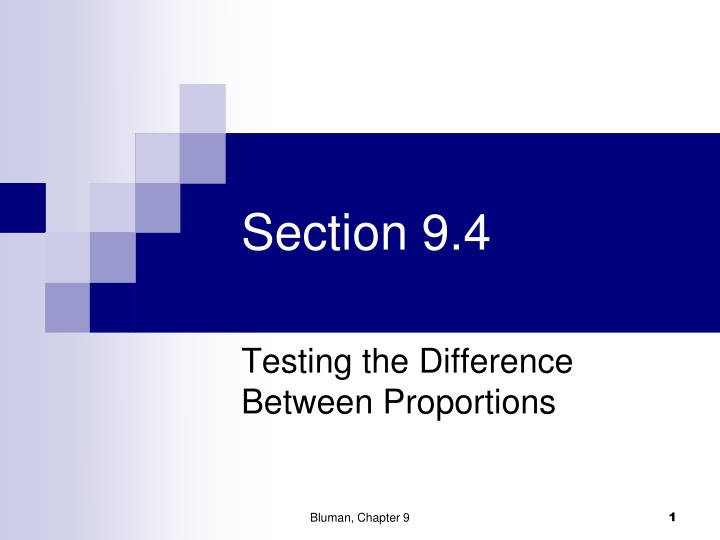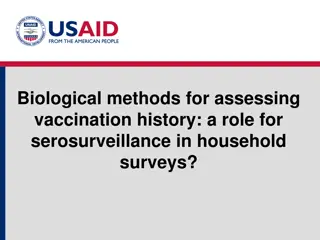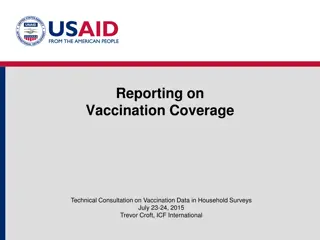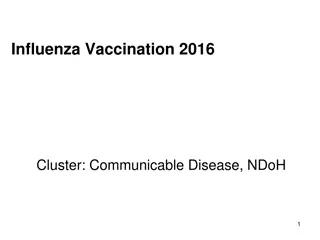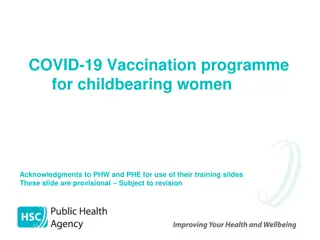Testing the Difference Between Proportions in Nursing Home Vaccination Rates
This content discusses a statistical analysis of vaccination rates in small and large nursing homes to determine if there is a difference in proportions of residents vaccinated. It covers hypothesis testing, critical value calculation, test value computation, decision-making, and result summary.
Download Presentation

Please find below an Image/Link to download the presentation.
The content on the website is provided AS IS for your information and personal use only. It may not be sold, licensed, or shared on other websites without obtaining consent from the author.If you encounter any issues during the download, it is possible that the publisher has removed the file from their server.
You are allowed to download the files provided on this website for personal or commercial use, subject to the condition that they are used lawfully. All files are the property of their respective owners.
The content on the website is provided AS IS for your information and personal use only. It may not be sold, licensed, or shared on other websites without obtaining consent from the author.
E N D
Presentation Transcript
Section 9.4 Testing the Difference Between Proportions 1 Bluman, Chapter 9
Test 9 Friday March 14 2 Bluman, Chapter 9
Review of symbols p p X Sample proportion p = n p Population proportion q q
Hypotheses; two tailed H0: p1=p2 OR H0: p1- p2=0 H1: p1 p2 H1: p1 - p2 0
9.4 Testing the Difference Between Proportions ( 1 2 = where ) ( 1 n ) p p p p 1 2 z 1 n + pq 1 2 + + X n X n X n X n = = p p 1 2 1 1 1 2 1 = = p 1 2 q p 2 2 5 Bluman, Chapter 9
Chapter 9 Testing the Difference Between Two Means, Two Proportions, and Two Variances Section 9-4 Example 9-9 Page #505 6 Bluman, Chapter 9
Example 9-9: Vaccination Rates In the nursing home study mentioned in the chapter- opening Statistics Today, the researchers found that 12 out of 34 small nursing homes had a resident vaccination rate of less than 80%, while 17 out of 24 large nursing homes had a vaccination rate of less than 80%. At = 0.05, test the claim that there is no difference in the proportions of the small and large nursing homes with a resident vaccination rate of less than 80%. 12 0.35 and 34 12 17 29 34 24 58 + + n n 17 24 X n X X n = = = = = = p 0.71 1 2 p 1 2 1 2 + + X = = = = = 0.5, 0.5 1 2 p q 1 2 7 Bluman, Chapter 9
Example 9-9: Vaccination Rates Step 1: State the hypotheses and identify the claim. H0: p1 p2 = 0 (claim) and H1: p1 p2 0 Step 2: Find the critical value. Since = 0.05, the critical values are -1.96 and 1.96. Step 3: Compute the test value. ( 1 = z ) ( 1 n ) ( ) ( ) 1 34 0.35 0.71 p p p p 0 2 1 2 = 1 24 1 n ( )( ) + 0.5 0.5 + pq 1 2 = 2.7 8 Bluman, Chapter 9
Example 9-9: Vaccination Rates Step 4: Make the decision. Reject the null hypothesis. Step 5: Summarize the results. There is enough evidence to reject the claim that there is no difference in the proportions of small and large nursing homes with a resident vaccination rate of less than 80%. 9 Bluman, Chapter 9
Chapter 9 Testing the Difference Between Two Means, Two Proportions, and Two Variances Section 9-4 Example 9-10 Page #506 10 Bluman, Chapter 9
Example 9-10: Missing Work In a sample of 200 workers, 45% said that they missed work because of personal illness. Ten years ago in a sample of 200 workers, 35% said that they missed work because of personal illness. At = 0.01, is there a difference in the proportion? p To compute , you must find X1andX2. ( 1 1 1 0.45 200 = = X p n ( 2 2 2 0.35 200 = = X p n ) = 90 ) = 70 + + + + 90 200 70 200 160 400 X n X n = = = = = 0.4, 0.6 p q 1 2 1 2 11 Bluman, Chapter 9
Example 9-10: Missing Work Step 1: State the hypotheses and identify the claim. H0: p1 = p2 and H1: p1 p2 (claim) Step 2: Find the critical value. Since = 0.01, the critical values are -2.58 and 2.58. Step 3: Compute the test value. ( ) ( 1 2 = = ) ( ) ( ) 1 200 0.45 0.35 p p p p 0 1 2 = z 1 1 n 1 n ( )( ) + 0.4 0.6 + pq 200 1 2 2.04 12 Bluman, Chapter 9
Example 9-10: Missing Work Step 4: Make the decision. Do not reject the null hypothesis. Step 5: Summarize the results. There is not enough evidence to support the claim that there is a difference in proportions. 13 Bluman, Chapter 9
Confidence Interval for the Difference Between Proportions Formula for the confidence interval for the difference between proportions 1 1 p q n p q ( ) + p p 2 n 2 z p p 1 2 2 1 2 1 2 1 1 p q n p q ( ) + + p p z 2 n 2 1 2 2 1 2 14 Bluman, Chapter 9
Chapter 9 Testing the Difference Between Two Means, Two Proportions, and Two Variances Section 9-4 Example 9-11 Page #508 15 Bluman, Chapter 9
Example 9-11: Confidence Intervals Find the 95% confidence interval for the difference of the proportions for the data in Example 9 9. 12 34 17 24 X n X n = = = 1 0.35 = = p q 0.35 and 0.65 1 1 1 1 = = = 1 0.71 = = p q 0.71 and 0.29 2 2 2 2 1 1 p q n p q ( ) + p p 2 n 2 z p p 1 2 2 1 2 1 2 1 1 p q n p q ( ) + + p p 2 n 2 z 1 2 2 1 2 16 Bluman, Chapter 9
Example 9-11: Confidence Intervals Find the 95% confidence interval for the difference of the proportions for the data in Example 9 9. ( )( 0.35 0.65 0.35 0.71 1.96 34 ) ( )( 24 ) 0.71 0.29 ( ) + p p 1 2 ( )( 34 ) ( )( 24 ) 0.35 0.65 0.71 0.29 ( ) 0.35 0.71 + + 1.96 0.36 + 0.242 0.36 0.242 p p 1 2 0.602 0.118 p p 1 2 Since 0 is not contained in the interval, the decision is to reject the null hypothesis H0: p1 = p2. 17 Bluman, Chapter 9
On your own Study the examples in section 9.4 Sec 9.4 page 510 #3,7,11,15,17,19 18 Bluman, Chapter 9
